Since Universal Robots launched in North America in September 2012, the user-friendly, lightweight robot arms from Denmark have been met with overwhelming interest from distributors and customers, the company said. Return on investment is 3-8 months; 80% operate without enclosures. Link to videos.
Universal Robots’ collaborative robots have opened up a new market for robotics in North America. The distributor list of the Danish robotic arms is rapidly expanding as resellers show the robots to end customers with production processes previously thought impossible to automate due to cost and complexity, the company said. Universal Robots, introduced to the U.S. market at IMTS in September 2012, also demonstrated its robotic arms at the Automate Show in Chicago Jan. 21–25, 2013.
Ed Mullen, national sales manager with Universal Robots, handled the U.S. expansion, noting advantages such as easy programming, portability, and relatively low cost. “That’s why people are literally lining up to help us sell it,” he explained.
Key benefits of the robots, the company said, are that they are simple to program, easy to install, have flexible deployment, can run without fence, have quick return on investment (ROI), work independently without need for human monitoring and control, are extremely quiet without irritating robot noise, are energy-efficient, and have modular design. Payback period is typically 3-8 months, the company said.
Gary Eliasson, president of Axis Inc., said customers have applications for the UR robot that no other robotic solution can address. “There’s a dramatic difference between Universal Robots and other competitors. UR is the only collaborative robot that can work with no protection while offering so many capabilities in terms of precision handling, flexibility, and payload,” Eliasson said.
Philip Hollingsworth, senior applications engineer with Sparkem Technology, experienced the robotic arms at IMTS. “We came back from the show thinking, ‘We’ve got to get these!’ We’re always looking for solutions that will be a differentiator and give our customers an advantage,” said Hollingsworth, adding that it took his team literally an hour to bolt down the UR robot, position it, and program it to perform 10 movements. “Most robotics solutions have a lot of setup, but the UR robot was incredibly easy and intuitive,” said Hollingsworth.
Chuck Mulcrone, Applied Controls sales manager, has already sold several Universal Robots, praising how the “robots can work alongside personnel with no safety guarding. This is a huge incentive for our customers as other robotic solutions that need guarding are cost prohibitive.”
Bill Steury, group president with Cross Company Automation Group, also stresses the collaborative aspect of the UR robots: “We believe the unique value proposition of UR’s collaborative robotic solutions will enable our customers to implement flexible automation solutions faster and more cost effectively than ever before,” he says.
Matt Gallagher, president of Braas Company, expects the robots to be deployed in a vast range of industries spanning OEM machine builders, manufacturers of medical devices and electronics, injection molding, machining, and packaging. Gallagher said, "We provide grippers, machine vision, PLCs, conveyors, and a range of other components that will interface seamlessly with the built-in logic and capabilities of the UR robots. The company has hit the mark with a robust product that can be programmed and implemented by users without any programming or robotics experience.”
Since Universal Robots sold its first robot in 2009, the company has seen rapid growth in more than 40 countries worldwide. Thomas Visti, chief commercial officer with Universal Robots, anticipates this trend to continue in North America: “We’ve created an incredibly strong lineup of distributors that are all well positioned within our target markets, so we’re off to a very promising start.”
The robots
Universal Robots is a result of many years of intensive research in robotics, the company said. The product portfolio includes the UR5 (working radius: 85 cm or 33.46 in.) and UR10 (radius: 130 cm or 51.18 in.) models that handle payloads of up to 11.3 lb (5 kg) and 22.6 lb (10 kg), respectively. The six-axis robot arms weigh as little as 40 lb. The UR robots are in compliance with the ISO standard for collaborative robots; as soon as an employee comes into contact with the robot arm, the robot arm will automatically stop operating. (See Robot vs. Viking photo at top.) Robotic Industries Association R15.06 standard allows humans in the loop of robotic operations.
In a collision, the robot delivers less force than the 150 Newton (33.72 lb) regulatory limit [EN ISO 13850], so, depending on the application, Universal Robots may be able to operate without an enclosure. Of course, end-effectors and other environmental conditions could create a hazard, and a risk assessment should be done with any industrial motion control application. In 2,000 applications, 80% of Universal Robots do not require an enclosure, the company said.
Repeatability of +/- .004 in. allows quick precision handling of even microscopically small parts. The collaborative robots can quickly be moved around production sites and are easily integrated in all industries—from the small machine shop to the large auto assembly line.
The company is headquartered in Odense, Denmark, where development and production is carried out.
– Edited by Mark T. Hoske, content manager, CFE Media, Control Engineering and Plant Engineering, [email protected].
Universal Robots offers a video.
As of late January, the Universal Robots map shows 10 U.S. distributors.
Control Engineering video short: See below how a Universal Robots UR5 works with ROS Industrial open source programming software.




